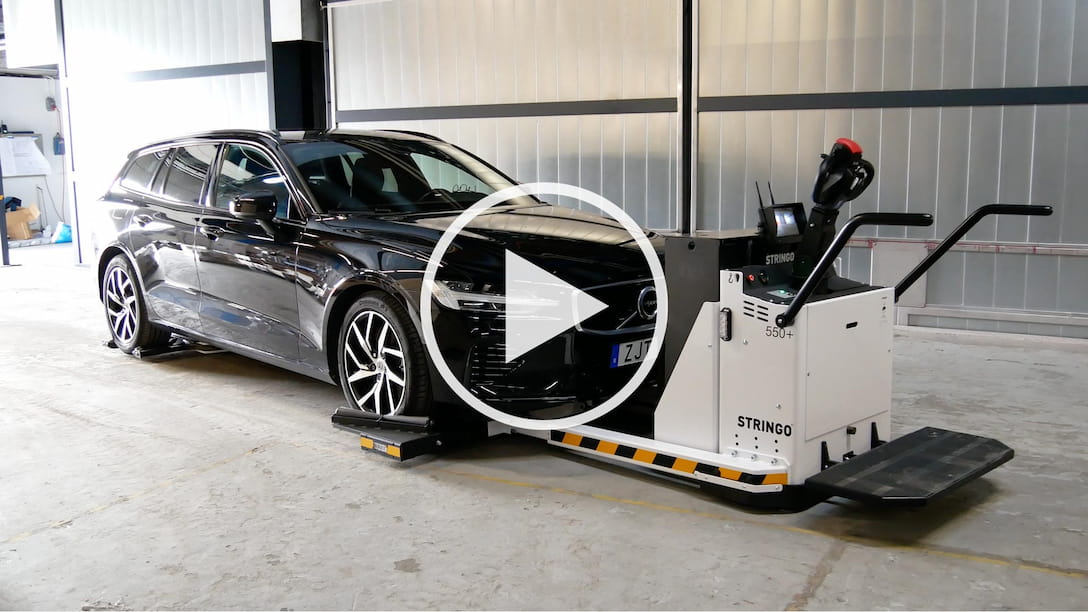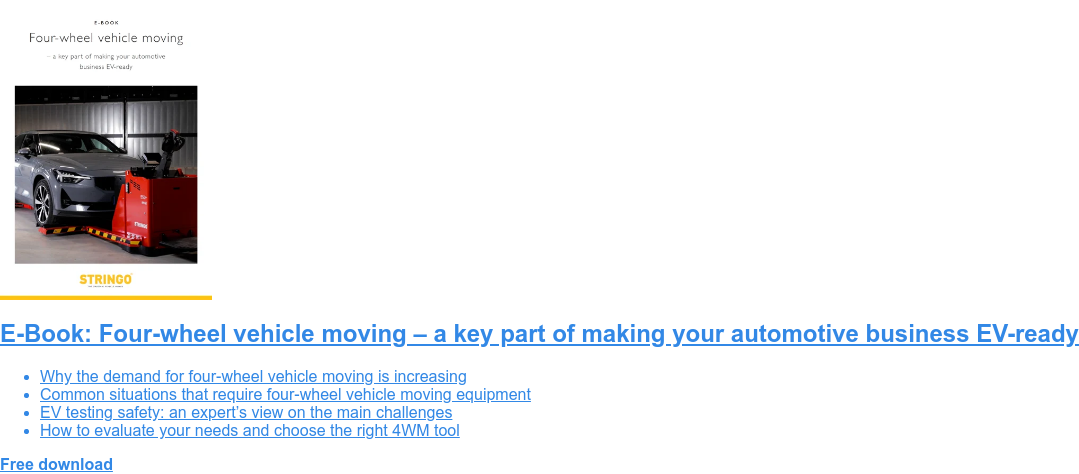Recently, there’s been an increased demand for solutions that enable four-wheel vehicle moving from various sectors of the automotive industry. The electrification of cars in general and the development of EVs in particular, have changed the needs at the end-of-line and of car testing facilities. As a result of this, the industry has seen the need for being able to move vehicles by all four wheels in new and novel ways. To understand this trend, and to learn more about all the aspects of four-wheel vehicle moving, we asked one of the top experts in the industry, Magnus Grafström, CTO of Stringo, to explain the phenomena and present the different four-wheel vehicle moving solutions on the market.
What is a four-wheel vehicle mover?
Grafström: A four-wheel vehicle mover is a solution that enables you to move a vehicle by lifting all four wheels. That way you can move a car without starting the engine, and without rotating any of the four wheels.
Explain the need for a four-wheel vehicle moving solution
Grafström: Traditionally when moving cars it’s usually been enough to simply lift one wheel pair to move a vehicle in situations where the engine can not, or should not, be started. But with the increased electrification of cars, there’s now an emerging need for four-wheel solutions. Parking brakes are now commonly electric and when the car is in parking mode, all four wheels lock. In these cases, the parking brake can’t be released without turning the power on. For EVs, there’s also the issue that if you rotate the wheels – the movement will generate electricity into the electric system of the vehicle, which can damage electrical parts. To move these types of cars you need a four-wheel vehicle mover solution.
.jpeg?width=1023&name=Stringo%20(1).jpeg)
But production environments have a different set of challenges to address, isn’t that right?
Grafström:– Absolutely. Vehicle movers in production environments are critical at the end-of-line for getting non-starting vehicles off the assembly line. One common problem with cars that don’t start is that there’s an issue with turning on the power, like a battery being dead. For a lot of the modern cars manufactured today, this means you won’t be able to disengage the parking brake, and you would need a four-wheel vehicle mover to move them off the assembly line.
We see the biggest four-wheel moving need in EV production environments, especially at the end-of-line where EVs need to be moved off the assembly line without risking electricity to be generated into the electric system of the vehicle. At most manufacturing sites, a new vehicle comes off the assembly line every 60 seconds so you need a vehicle mover that is flexible and easy to use. It also has to get the car out of the way quickly. For these needs, the Stringo DuoMover is the perfect fit as it allows that flexibility.
How do testing facilities use four-wheel vehicle movers?
Grafström: We see the need for four-wheel vehicle movers in manufacturers’ testing facilities when running tests on dyno cells, in wind tunnels, or in climate chambers. You won’t be able to start the engine or there are situations where you run a test and the vehicle breaks down. Then, you would need a four-wheel vehicle mover to move the car in or out of the test facility. The way the dyno cells are designed makes it difficult to use a traditional vehicle mover in combination with the Stringo DuoMover to get the car on the platform, so you’d have to use a dedicated four-wheel mover, like the Stringo 4WM, or a customized solution for the specific conditions of your unique testing environment.
.jpeg?width=1023&name=Stringo%20bild%20(1).jpeg)
In what other scenarios would you need a four-wheel vehicle mover?
Grafström: The police, for instance, might need to move an evidence vehicle in a four-wheel way. Another example is private collectors that need a flexible way to move around valuable cars when all four wheels are locked. The scenarios vary a lot.
What can you say about the future need for four-wheel vehicle movers?
Grafström: The electrification of cars and the issue with moving EVs when the engine is switched off are the factors that drive the trend of four-wheel vehicle moving – and will drive this trend in the future as well. So the four-wheel movers are here to stay. There is a great demand for customized product deliveries today and that is something that will remain important also in the future. What kind of four-wheel moving solution that’s right for you will depend on a variety of factors. The smartest way to find out is to use a supplier with all the know-how to evaluate what solution is best for your unique conditions and area of use.
Learn more about four-wheel vehicle moving in our e-book
Our e-book on four-wheel vehicle moving further explains why this is a crucial factor in the ongoing electrification of the automotive industry. Download your copy to find out more.







